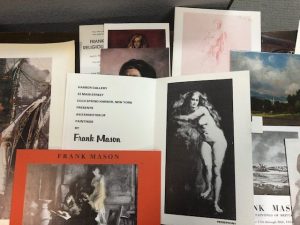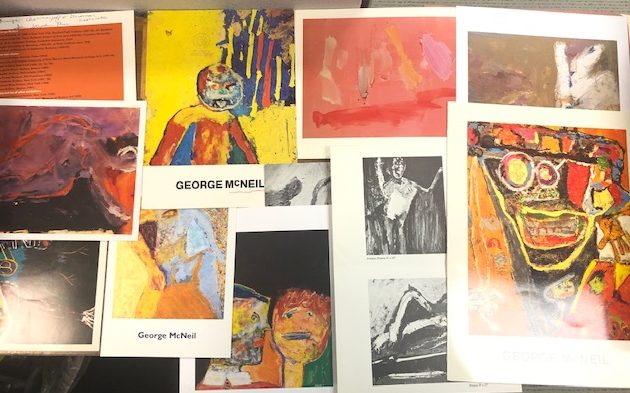This post was contributed by Natalia Addison, 2020 spring intern with the American Art and Portrait Gallery (AA/PG) Library and a recent Master of Science in Information and Library Science graduate from Clarion University.
Working at the prestigious Smithsonian Institution has always been a dream that I’ve held. Thus, obtaining an internship at the American Art and Portrait Gallery Library (AAPG Library) in the spring of 2020 was a manifestation of that dream. Here, I learned how to process and select materials for the Art and Artists File Collection. I learned how to do intensive art research on artists, and learned when, why, and how to add new items to those artist files. I learned preservation practices, analysis techniques, and was able to expand my knowledge about the artists. I was able to use the knowledge I gained through my courses at Clarion University to serve patrons through an unfamiliar integrated library system. It is through this opportunity that I found what I suspected all along to be true: that I want to continue to pursue my dream of becoming an art librarian.

Much of my time at the AAPG Library was spent working with art ephemera. Ephemera, in relation to libraries, is printed material that is not meant to last or to be kept for a long time. For the artists represented in an art library, these pieces of ephemera are important parts of their histories. Artist files hold “private view cards, exhibition announcements, press releases, newspaper clippings, artists’ correspondence, posters and flyers, emails, and other materials.”[i] These items are important as reference pieces as they can contain significant documentation on artists that is not easily found elsewhere especially for artists who may not be well covered in mainstream or standard resources.
As a Library Science Graduate student, learning how ephemera is used, and how to access it, was an important and fascinating aspect of my internship. During ordinary circumstances when the library is open, researchers can come into the library and request files to view and library staff will pull the files for them. Being able to sort through the artist files myself during my internship really helped me understand how and why ephemeral materials are so important. I also learned how to label the artist folders, strategically stamp materials to note the donation they came from, carefully remove all harmful extraneous materials, and place them in protective coverings.
Sorting through the ephemeral materials in the artist files was a dream come true. Being able to see how the artists represented themselves through postcards and exhibition materials was so inspiring. Ephemeral materials allowed me to see how art was displayed by artists or galleries. I was able to see the stories of artists in news clippings and read about how their contemporaries viewed their works. Some files had letters, sometimes from the artist themselves. Artist files allow researchers a glimpse into the mind of the artist, and a deeper connection to the artwork. So much of the work that I did reminded me of my childhood days: saving postcards and tags from garments, making collages, and researching the brands and artists.

The impact of COVID-19 changed the nature of my internship. I was able to continue online and in spite of the changes I learned a great deal. Together with my internship supervisor, Alexandra Reigle, we decided that the best way to continue would be to focus on readings and assignments that related to special collections (particularly artist files), topics specific to art and museum libraries, and reference services. Together we had weekly meetings to discuss the articles and projects to ensure that the internship was still on track. Thanks to my supervisor’s diligence I learned more than I thought possible interning from home.
For one of my assignments I developed my own ephemeral collection. I used items around my home and put them together to showcase why I thought they would be a great addition to an artist file. In this instance I choose a luxury department store as the “Institution.” I used packaging, postcards, flyers and mailers to demonstrate the ephemeral nature of the items. They could be of importance for the history of the company for anniversaries, corporate literature, or future design. Thinking about ephemera from outside an artist perspective was a great lesson on how valuable these items can be. This allowed me to utilize both my life’s passions and areas of expertise: fashion and art literature.
Since working remotely I’ve also attended an online symposium on American Art, and a presentation on trade literature collection at the National Museum of American History Library as part of my internship. COVID-19 has made digitization efforts and issues seem especially pronounced. Patrons of all libraries have had to adapt to researching online and contend with inaccessibility of items that would normally be available. While I’ve been grateful that I was able to continue my internship and feel that I learned a lot in the process, it has not been without its difficulties. One of the best aspects of my internship was getting to be in the AA/PG library. Seeing the volumes of books and magazines in person inspires creativity that simply cannot be matched at home.
My experience as an intern at the AA/PG Library was one of the most important and influential times of my life. This internship granted me the opportunity to see first-hand what it means to be a reference librarian at an art library. I was also able to learn important research habits and interact with some of the finest minds in the art library world. This internship cemented and reinforced my love of art and libraries, and I feel encouraged to continue to pursue my dream of becoming an arts librarian.
[i] Kent C. Boese, “Relics of the Past, or Treasures for Posterity?” Art Documentation: Journal of the Art Libraries Society of North America 25, no. 1 (Spring 2006), 34.


Be First to Comment